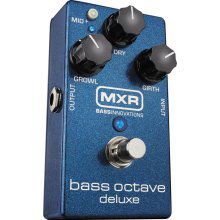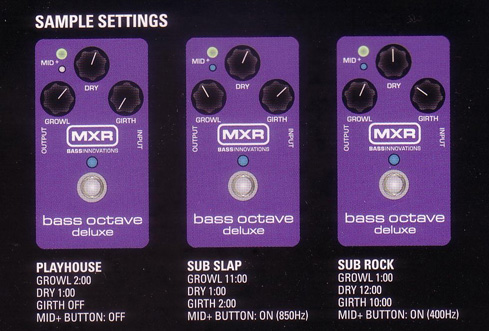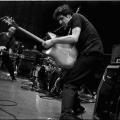The following is a guest post by Jeremy Cohen. If you are interested in guest posting, please contact me!
 In my role as a bass teacher, I often am asked, “what effects pedals should I get?”
In my role as a bass teacher, I often am asked, “what effects pedals should I get?”
The simple answer is that bassists really don’t need pedals, but then I follow that up by telling what the most useful effects for bass are. A an octave pedal is definitely one of these. It is an effect which adds an octave below the note you are playing and it is a simple way to enhance the sound of a bass. Pino Palladino made a name for himself with extensive use of an octave pedal with a fretless bass. You can hear this most notably on the song, I’m Gonna Tear Your Playhouse Down, recorded with Paul Young. Here’s a nice live version (a little faster than the original). Keep listening to hear what he does at the end of the song.
[iframe_loader width=”425″ height=”344″ frameborder=”0″ longdesc=”” marginheight=”0″ marginwidth=”0″ name=” click_words=”” click_url=”” scrolling=”auto” src=”http://www.youtube.com/embed/Nc5BdkCcuSc”]
Of course, in my role as a freelance bassist, I often bring a large pedal board with me. This usually causes the other players to groan, “oh, no, please don’t use those!” If I brought every pedal I owned, they would go into shock. However, once I start playing, I use the pedals sparingly. When I use the octave pedal, generally one of the other musicians will turn around and smile at me.
Over the years, I have owned a variety of pedals including the Boss OC-2 pedal and the EBS Octabass. Now that I have had the MXR M288 Bass Octave Deluxe for a while, I can say that this pedal gets the sound for which I have been searching for years.
One of the features necessary in an octave pedal is good tracking and this pedal definitely tracks well, not only for single notes, but also for double stops (two notes at once). When using an octave pedal, just make sure you don’t play notes below A. The pedal may be able to produce those sounds, but your speakers won’t. I generally try to avoid going below C.
The next feature you need in the pedal is the ability to mix your straight bass sound with the octave sound and once again this pedal comes through using a control which is called Dry. Turning this dial all the way to the left will give you just the octave sound and to the right will give you almost no octave sound. You will want to start with the control and the middle and then adjust it to get the blend you want.
The unique feature of the MXR pedal is that it has two distinctly different octave bass sounds. MXR calls one sound Girth and this is a clean and smooth octave-below sound. The other sound is called Growl. This sound has more bite and to me it sounds very much like a synth bass doubling your notes. The two sounds have independent controls and can be blended together, giving this pedal a wide range of available sounds.
There is also a mid-range boost switch and the particular frequency and intensity of this boost can easily be adjusted with an internal slide switch and trim pot. I like the sound of this boost the way it was set at the factory, but your mileage may differ.
Other features of the pedal are its extremely small size and internal circuitry which will keep the unit functioning properly even if the battery voltage starts dropping. The pedal is also true-bypass, which means that your signal completely bypasses all internal circuitry when the pedal is switched off.
The instructions that come with the pedal include three sample settings: Sub Slap, Sub Rock, and …. Playhouse. (hmm…)

The price of this pedal is not out-of-line with that of other pedals of this type, especially since the Boss OC-2 pedal has now become collectible and prices for that one are going up steadily.
I strongly recommend this pedal for anyone who is covering songs on which the original recording had a synth bass part or a synth doubling the bass part You could also use it on a song in which the guitar is doubling the bass part. Then you will free up a guitarist to play a different part. It also will instantly make any solo stand out. These are uses in which the pedal works for me and you will probably find some more uses once you have the unit.
One more feature I almost forgot to mention is that the pedal is blue so it matches my main bass, a Mike Lull M4V with a custom blue sunburst finish! Next time we meet, I’ll talk about other types and models of pedals which might be useful for a bassist to own. Happy bass playing!
Jeremy Cohen has been playing bass for over 40 years. He works as a bassist in the S.F. Bay area and is first call bassist for a variety of bands. He is known for tasteful, solid playing, sight-reading ability, the amount of preparation he does before gigs, and his ability to walk into any situation (with charts or not) and fit in.
He also has taught many students over the years and is extremely proud of all his students. Read what Matt Freeman of Rancid has to say:
http://www.jeremycohenbass.com/BParticle.09.pdf
Read, listen and see more about him at http://www.jeremycohenbass.com
His CD is on sale at http://www.cdbaby.com/cd/jazzexpress


